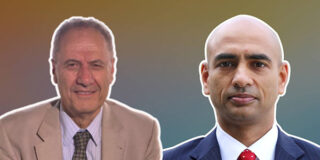Fair Observer Founder, CEO & Editor-in-Chief Atul Singh (the Rajput) and retired CIA Officer Glenn Carle (the WASP) unpack Iran’s long journey from imperial power to revolutionary state. Drawing on centuries of Persian history, Western intervention and ideological transformation, they trace how a proud civilization came to see itself at odds with the United States and Israel. The conversation moves across empires, coups and revolutions to examine what drives Iran’s foreign policy — and where the country might be headed next.
Persia’s imperial legacy and civilizational pride
Atul opens by confronting reductive Western stereotypes of Iran as a land of “bearded mullahs.” He insists that Iran stands among the world’s great civilizations, rooted in the legendary Persian Empire. After its fall, Persia reemerged as a distinct Shia power, especially with the rise of the Safavid dynasty in 1505. Glenn notes that Western foreign policy education largely ignores Persia’s influence unless filtered through ancient history courses. Atul counters that blindness to history exists everywhere.
Iran’s connection to India runs deep. Atul links the fall of the Mughal Empire to Nader Shah’s 18th-century invasion, which weakened India and paved the way for British conquest. The Persian language dominated Indian courts for centuries, and Persian culture left lasting marks — like the Taj Mahal, built for a Persian princess. The Safavids, Atul and Glenn agree, cultivated a vision of imperial greatness that still defines Iranian identity today.
Colonial humiliation and foreign exploitation
Iran’s decline followed Nader Shah’s death. The Qajar dynasty proved weak, losing land to Russia and succumbing to British manipulation. London viewed Persia as a buffer against Russia to protect India, and Atul provocatively blames India for drawing Britain deeper into Persian affairs. Misrule, famine and quasi-colonial control devastated the country.
Hope flickered during the Persian Constitutional Revolution of 1905–1911, but Reza Shah Pahlavi’s 1921 coup ended that brief democratic experiment. An officer in the Persian Cossack Brigade with autocratic instincts, Reza Shah imposed nationalism, militarism and censorship. While some credit him with modernization, Atul dismisses him as a pretender mimicking Nazi Germany and Fascist Italy. Glenn agrees that such regimes offer tempting models amid disorder and religious conservatism.
The real turning point, the speakers argue, came when UK Prime Minister Winston Churchill converted the Royal Navy from coal to oil. This made Persia’s oilfields essential to Great Britain. In World War II, the Allies invaded Iran to secure access to that oil, sidelining Reza Shah. Iran became a vital Lend-Lease corridor to the Union of Soviet Socialist Republics (USSR), and the 1943 Tehran Conference promised Iranian independence to calm growing unrest.
The 1953 coup and the birth of resentment
After the war, Britain clung to Iran’s oil despite losing influence elsewhere. Mohammad Mossadegh, a secular nationalist, sought a fair deal and demanded a 50/50 oil split like the US–Saudi model. When Britain refused, he nationalized Iranian oil. The British then convinced the US, particularly the anti-communist Secretary of State John Foster Dulles, that Mossadegh posed a Soviet threat.
Despite Mossadegh’s hostility to communism, the CIA and MI6 staged a coup in 1953. They ousted Mossadegh and reinstalled the Shah, preserving British oil interests. Glenn calls this one of the “triumphs of CIA history” that spawned decades of unintended consequences. Atul calls 1953 a “seminal year” for Iran, triggering a psychological fracture — an inferiority complex born of colonialism mixed with the superiority of the lost empire.
The Shah’s fall and the Islamic Revolution
Between 1953 and 1979, Iran modernized under the Shah, aligning with Israel and benefiting from oil revenues. But Atul argues that the wealth served only a narrow elite. The Shah ruled through opulence and repression, crushing dissent with his brutal secret police, Sâzemân-e Ettelâ’ât va Amniyat-e Kešvar, or SAVAK. This silenced opposition until the clergy emerged as the only outlet for resistance. Atul sees a straight line from 1953 to the revolution of 1979.
That year, Ayatollah Ruhollah Khomeini returned from exile and established a revolutionary Islamic regime. It embraced a vision of Iran as a global power, steeped in cultural pride and anti-colonial fury. For many Iranians, Islam became not just a faith but a response to Western domination and a symbol of national honor. The US came to represent the “Great Satan,” and Israel became the “Jewish crusader state.” Conspiracy theories and antisemitism often filled the ideological void.
War, proxy conflicts and regional influence
Post-revolutionary Iran endured an eight-year war with Iraq, during which the US backed Iraqi President Saddam Hussein to contain Iran. The Islamic Republic’s ideology failed to unite the wider Muslim world due to the Shia–Sunni divide. Iran instead embraced asymmetric warfare, funding armed groups like Hezbollah, the Houthis and even Hamas, despite its Sunni identity. Glenn notes that the US invasion of Iraq in 2003 only strengthened Iran’s reach, effectively expanding its sphere of influence into Iraq.
Iran today: pressure, paralysis and possibility
The Obama-era nuclear deal, called the Joint Comprehensive Plan of Action, marked a rare thaw, but US President Donald Trump’s 2018 withdrawal reignited tensions. Iran and Israel now battle through proxies and targeted attacks. Atul and Glenn outline six possible futures:
- Restoration of the Shah: Some monarchists hope for the return of the Pahlavi dynasty, but Atul calls this “unlikely.” The current regime has dismantled the monarchy’s legacy too thoroughly, and the exiled royal family lacks meaningful political traction inside Iran.
- Democratic revolution: Support for the clerical regime is weak, and Iran’s well-educated, pro-Western population may eventually demand sweeping democratic change. For now, however, state repression makes mass mobilization difficult. Atul feels this outcome is unlikely in the short term.
- Islamic Revolutionary Guard Corps (IRGC) takeover: The already-powerful IRGC could consolidate control and run Iran as a military regime, much like Pakistan’s army dominates its civilian government. Glenn sees this as the most likely scenario in the near future.
- National disintegration: Iran could see ethnic fragmentation, with Azeris, Balochis, Kurds and others seeking autonomy or secession. Glenn calls this outcome “less likely but not inconceivable,” pointing to Iran’s internal diversity and existing regional tensions.
- Status quo: While Iran’s clerical leadership still holds power, the regime’s legitimacy is eroding rapidly. This scenario is unstable, as internal dissent, economic pressures and international isolation grow more acute.
- Liberal evolution: A moderate, secular leader could emerge to unify the population. This would require a significant political shift and public appetite for reform, especially among younger Iranians. Glenn finds this unlikely, but considers it a possibility.
Atul underscores Iran’s strengths: high literacy rates, especially among women, and a public that largely favors the West. These factors create internal pressure for change. Still, Iran navigates a volatile region and juggles rivalries with Turkey, Saudi Arabia, Russia and China. Atul compares Iran to “a ship being tossed around on the sea, in very choppy waters.”
Iran’s imperial ghosts and modern struggles
Glenn concludes by saying Iran’s geography and cultural legacy shape its worldview. The regime sees itself as a rightful power, hostile to colonialism, wary of Sunni rivals and deeply suspicious of Western intervention. The 1979 revolution sharpened those instincts. Yet as both Atul and Glenn warn, a post-mullah era may not bring peace or democracy. Like the Soviet collapse, it could usher in chaos.
Atul closes with a caution: Change alone doesn’t guarantee progress.
[Lee Thompson-Kolar edited this piece.]
The views expressed in this article/podcast are the author’s own and do not necessarily reflect Fair Observer’s editorial policy.

















Comment